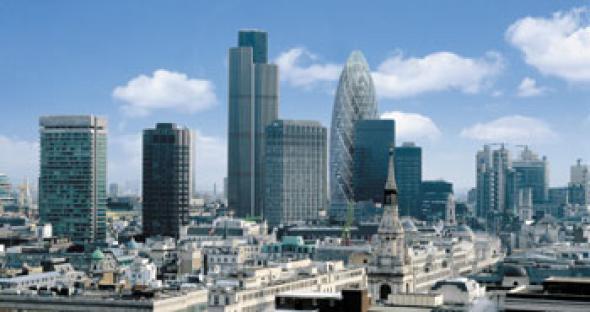Topology of a Phantom City
Turn of the century London is bristling with new developments both residential and commercial.
Lost your bearings in the new urban jungle? David Panos updates the A-Z, complete with key.
Turn of the century London is bristling with new developments both residential and commercial. The lottery is redirecting public monies towards architectural schemes and even the Evening Standard is getting excited about the possibility of hi-tech skyscrapers remodelling the skyline [link 5: SKYSCRAPERS] . The thousands of people flooding Bankside to admire the Tate Modern and the ill-fated Millennium Bridge [link 3: NEW MONUMENTS] testify to a healthy popular appreciation of the new (or at least the reclaimed!). Today’s populist vision of the ideal home (loft living + wallpaper + Ikea) [link 1: LOFTS] has replaced the stifling quietism of traditional British suburbia with a new cosmopolitanism.
Despite this ‘Urban Renaissance’ [link 1 – 5] it is difficult to trace any coherent architectural thinking behind the flurry of activity. “Everything is simultaneously available,” claims Kevin Rhowbotham of the Alphaville practice, “but there is no teleology. Architecture can’t pretend to have a view of itself unless it understands what it’s doing and who it’s doing it for.” The transformative postwar vision that gave us the council blocks of the sixties [link 2: WALLPAPER MODERNISM] has gone, its products repurposed as desirable middle class residences for ‘swinging’ Londoners [link 4: GENTRIFICATION].
Lack of vision is most evident in the projects more directly associated with the Blair administration [link 3: NEW MONUMENTS]. National Lottery money earmarked for ‘architecture’, particularly the rejuvenation of museums and galleries, has had little effect upon exterior or archival space. Instead, a rigid set of funding criteria founded on New Labour shibboleths like sustainability and public access have given birth to a formulaic all-purpose solution of shop, café and glass roof. ‘Public’ space is now denoted by the opportunity to consume souvenirs and lattés in a greenhouse. [link 3: NEW MONUMENTS]
Shopping has become a universal condition, outflanking outdated concepts of social progress or public culture. In the absence of a political mission, branding has become a big concern for architectural thinking, as Rem Koolhaas’s work for Prada amply demonstrates. The huge canvas brand ads draped over scaffolding around Central London, creating a 2D environment dominated by image and text, could progress into a more sensitive and sophisticated 3D realisation of brand identity. Rhowbotham’s partner Clive Saul foresees a future of partnership funding and maintenance contracts where brands take on responsibility for urban conditions, lending an aesthetic to street furniture, installations and buildings. Experiential brandzones like Nike town, recently accused of heralding ‘the end of architecture’, are merely the rather crude tip of the iceberg. Saul insists that this could be a good thing, and seems unconcerned that privatised space might outlaw demonstrations or free expression unpalatable to megacorps. Whereas the old order of public space could contain civil protests, he argues, brands would be forced to bow to serious pressure in their space for fear of bad PR.
There is no doubt that brands could become the default administrators of much of social existence in a post-political era. As our relationship to capital begins to lose its mediation through concepts such as citizenship, state and politics, it appears that architecture is turning to brands for ideas, or rather ‘simulacral themes’, to hang itself on.
David Panos <david AT senseworldwide.com>
(With thanks to Vicky Richardson, RIBA)
[link 1] Lofts and Reclamation Shoddily built and aggressively marketed developments vaguely signifying the loft-living ideal mark the triumph of pure surface over a considered architecture. As second-order as that of the neo-Georgian starter homes of the 1980s, their low quality will leave a legacy every bit as tatty as the most poorly maintained council estates. The Tate Modern could be the country’s biggest loft development yet…
[link 2] Wallpaper modernism Default retro-modernism has led to an increasingly homogenised world of plychairs and white walls – the all-purpose signifiers of ‘design’ traversing work, cultural institutions and the home.
[link 3] New MonumentsNew Labour’s attempts to create a ‘Pompidou’ spirit have given London a motley assortment of distinctly unmonumental semi-permanent monuments beset with technical errors and controversy.
[link 4] Gentrification The increasingly feverish hunt for cheap property has led to the gentrification of London’s most destitute areas. Low rent bohemia as an avant-garde for middle class settlement manifests itself in the hunt for industrial units or listed modernist council housing, resulting in a bizarre mishmash of new money and old poverty.
[link 5] Skyscrapers The two forty-story residential towers designed by Hanzah and Yeang earmarked for Elephant and Castle, the four-hundred and twenty metre Renzo Piano office block in development at London Bridge, Foster and Partners’ Swiss Re building, aka ‘The Gherkin’ – all these demonstrate a new pursuit of the impressive, the new, the big. You can go drink cocktails at the top of the newly rebranded Tower 42 and, bathed in neon, gaze down on the scum below…
Mute Books Orders
For Mute Books distribution contact Anagram Books
contact@anagrambooks.com
For online purchases visit anagrambooks.com








